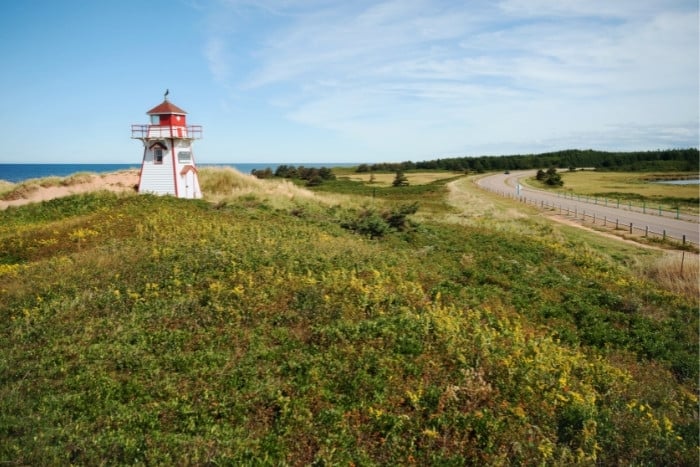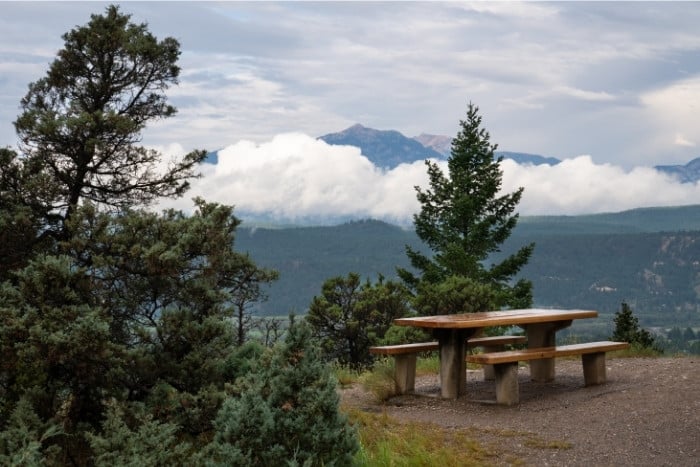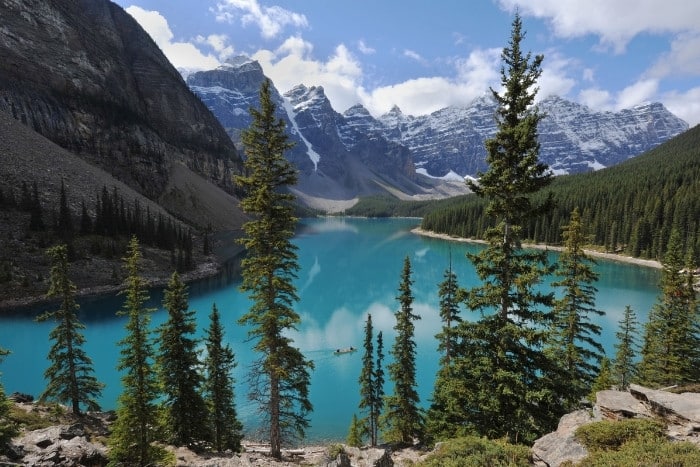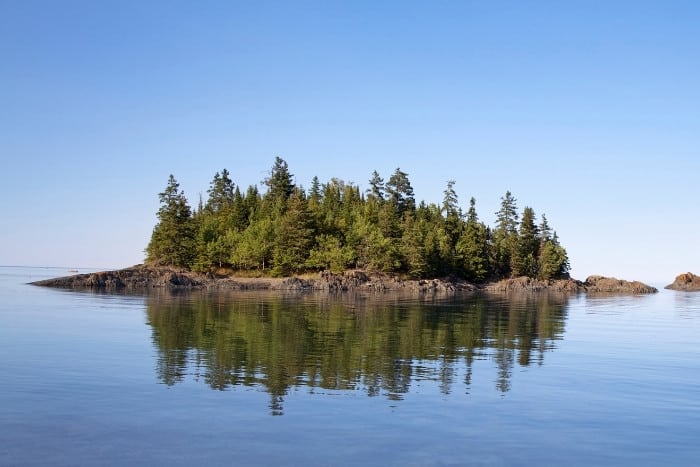The National Parks in Canada are unlike any other in the world. The parks showcase a natural winter wonderland, and are home to a variety of wildlife. You may have considered winter camping in one of these parks before, or maybe you’ve already visited some of the parks below, yet you’re still wondering, which is the best national park to camp in this winter?
Here is an in-depth guide to 20 of Canada’s best winter camping National Parks. We cover essential information such as the temperature to expect, best parks based on your interests, winter activities you can do, and offer some handy camping tips and what to expect when camping.
Read on to discover which National Park is your dream camping destination. Remember, one of the best things about Canadian National Parks is that dogs are allowed in most parks, unlike in the U.S! So your furry friend is never left behind.
Top Canadian National Parks For Winter Camping – Table Summary!
| National Park Name | Temperature | Winter Activities Available | Bottom Line |
|---|---|---|---|
| Prince Edward Island National Park, | Highs 30 to 20F Lows 10 to -10F | Ice Fishing, Sleigh Rides | Best for Glamping |
| Fundy National Park, New Brunswick | Highs 50 to 30F Lows 20 to -10F | Mountain Biking, Ice Skating and Tobogganing | Best for Those that Like Mountain Biking |
| Oka National Park, Québec | Highs 20 to 10F Lows 0 to -30F | Winter Hiking, Sledding and Skiing | Best for Those that like Camping in a Cabin |
| Algonquin Provincial Park, Muskoka Area | Highs 20 to 10F Lows 0 to -10F | Dog Sledding, Skiing and Snowshoeing | Best for Quieter Camping |
| Glacier National Park, British Columbia | Highs 10 to 5F Lows -5 to -15F | Snowshoeing | Best for those that like a Challenge |
| Strathcona Provincial Park, Vancouver Island | Highs 10 to 5F Lows -5 to -15F | Cross Country Skiing, Snowshoeing and Rock Climbing | Best for the Trail Seeker |
| Kootenay National Park, British Columbia | Highs 20 to 5F Lows 0 to -5F | Dog Sledding, Hiking, Skiing | Best for Families |
| La Mauricie National Park, Québec | Highs 45 to 30F Lows 5 to – 5F | Ice fishing, Hiking, Skiing | Best for Those that Like Rocks |
| Kouchibouguac National Park, New Brunswick, | Highs 50 to 30F Lows 14 to 5F | Birdwatching, Hiking, Snowshoeing | Best for the Bird Watcher |
| Riding Mountain National Park, Manitoba, | Highs 20 to 10 Lows 5 to -13 | Hiking, Wildlife Watching | Best for those That Like Safari |
| Kluane National Park and Reserve, Yukon | Highs 40 to 25F Lows 5 to -20F | Ice Fishing, Snowboarding and Dog Sledding | Best for Those that Want to see the Northern Lights |
| Bruce Peninsula National Park, Ontario | Highs 40 to 30F Lows to 20 to 10F | Challenging hikes | Best for Someone who Likes a Workout |
| Banff National Park, Alberta | Highs 20 to 5F Lows 10 to -15F | Ice Skating, Helicopter Tours | Best for Those that Want a White Christmas |
| Gros Morne National Park, Newfoundland and Labrador | Highs 35 to 20F Lows 10 to -5F | Skiing, Ice Fishing, Storm Watching | Best for the Camper that Likes to Ski |
| Grassland National Park, Saskatchewan | Highs 50 to 30F Lows 20 to 5F | Hiking | Best for the Survivalist Camper |
| Killarney Provincial Park, Ontario | Highs 50 to 30F Lows 5 to -10F | Snowshoeing, Skiing | Best for Night Photography |
| Wood Buffalo National Park, Northwest Territories | Highs 45 to 30F Lows -4 to -40F | Wildlife Watching | Best for Those That Want to Check Out the Wildlife |
| Terra Nova National Park, Newfoundland and Labrador | Highs 40 to 30F Lows 15F to -1F | Fresh and Saltwater fishing | Best For Those That Like Fishing |
| Bic National Park, Quebec | Highs 25 to 15F Lows 10 to 5F | Skiing and Snowshoeing | Best for Seal Watching |
| Point Pelee National Park, Ontario | Highs 35 to 25F Lows 25 to 15F | Hiking | Best for a Weekend Getaway |
Breakdown of Canada’s Best National Parks to Camp in Winter
Now, this is the juicy bit where we fill you in on all the details you need to decide which National Park you’ll visit.
In this guide, we’ve included several provincial parks because the wildlife is still protected in these areas, and the winter activities and camping styles are similar.
1. Prince Edward Island National Park
Temperature – Highs 30 to 20F | Lows 10 to -10F
Prince Edward Island National Park offers a bundle of fun, winter activities. Take a sleigh ride through the beautiful snow planes, or go ice fishing for oysters!
The new geodesic domes in the park are the best camping alternative to a tent. They make camping in winter a luxurious experience, the perfect option for someone that likes glamping.
If it’s feeling chilly, jump in the hot tub underneath the stars or light your BBQ up! Several pods are closed during the winter, so make sure you book ahead to avoid disappointment.

2. Fundy National Park, New Brunswick
Temperature – Highs – 50 to 30F | Lows 20 to -10F
Located on a rugged coastline, Fundy National Park offers spectacular white views over a half-frozen sea. Tent camping is offered on a first come, first serve basis.
The campground provides enclosed kitchen space and heated washrooms. It is recommended that you bring your lantern for the evenings.
If tent camping isn’t your jam, yurts, and cabins are available. Ice skating and tobogganing are available, as well as fat biking, like winter mountain biking, where you ride a lightweight bike with oversized tires.
Fundy offers several trails to get you started!
3. Oka National Park, Quebec
Temperature – Highs 20 to 10F | Lows 0 to -30F
Oka is located just over half an hour from Montreal, and in winter the view from the Calvaire d’Oka is like no other.
Tent camping is only available from May to mid-October, but compact cabins are available year-round. These sleep up to 4 people and come equipped with showers and a meal preparation space.
Perfect for those that like a bit of extra comfort. In winter, Oka offers winter hiking, skiing, and sledding!
Oka National Park also offers hippocampe wheelchairs which are wheelchairs adapted for winter trails with a ski under the front wheel.
4. Algonquin Provincial Park, Muskoka Area
Temperature – Highs 20 to 10F | 0 to -10F
Algonquin is a haven for winter wildlife, a winter snow enthusiast, and those that prefer a more isolated campout.
For the adventurist, camping in the backcountry is permitted year-round, where the only way to get to the campgrounds is by dog sled, snowshoeing, or skiing.
The most popular winter campground is Mew Lake which surrounds a picturesque lake and provides flush toilets and showers. There are yurts available if you need something warmer.
In February, Algonquin holds a Winter in the Wild festival, which celebrates the park’s natural beauty and all its winter activities.
5. Glacier National Park, British Columbia
Temperature – Highs 10 to 5F | -5 to -15F
Glacier National Park is for the winter camper who likes the pure, harsh wilderness.
The park can be extremely challenging with the punishing temperature drops, but it’s worth it for the icy lakes and frosty peaks. You must have a national park pass to camp in Glacier National Park over winter.
Even then, you must be sure you stay in an unrestricted winter area. This is for your safety, as avalanches are common during winter.
Also, be aware that the access road to the summer campgrounds is not plowed during winter, so you will have to go on foot to reach them.
6. Strathcona Provincial Park, Vancouver Island
Temperature – Highs 10 to 5F | -5 to -15F
Strathcona is the oldest park in British Columbia, and it’s the perfect camping spot for anyone that wants to escape and jump into the wild.
Strathcona has a great variety of trails; whether you prefer views of frozen lakes or tough inclines up a mountain, the park offers it all.
Although the low temperature may be intimidating, winters in Strathcona are usually mild unless you hit the peaks. The Park offers cross-country skiing, snowshoeing, and rock climbing.
Make sure you plan, as the campgrounds only work on a reservation basis.
7. Kootenay National Park, British Columbia
Temperature – Highs 20 to 5F | Lows 0 to -5F
As you enter the Kootenay National Park, you’ll be greeted by red rocks and dark emerald trees peeking out from the white snow.
The park has plenty of camping options, and reservations can be made up to two months in advance.
While Kootenay has a variety of activities during winter (from dog sledding to skiing), it also has three front country campgrounds. So it is super accessible for those that are not planning long hikes.
Alongside this, the Marble Canyon only has 30m of elevation, so it is perfect for families. There is also plenty of backcountry camping to escape the crowds.

8. La Mauricie National Park, Québec
Temperature – Highs 45 to 30F | Lows 5 to – 5F
La Mauricie is a winter wonderland located between the Montreal and Quebec corridor. The Park attracts rock enthusiasts as it showcases the Canadian Shield.
The Canadian shield is the largest exposed mass of Precambrian rock on Earth, having formed deep below the Earth’s crust and having been pushed to the surface about 955 million years ago.
The Rivière-à-la-Pêche campground allows tents all winter and provides access to an outhouse and covered kitchen with a wood stove, so you can get toasty while you cook.
You must purchase a permit for any activity you plan during your stay, whether fishing, skiing, or winter hiking.
9. Kouchibouguac National Park, New Brunswick
Temperature – Highs 50 to 30F | Lows 14 to 5F
Winter in Kouchibouguac Park offers a fun and accessible camping experience.
The Petit-Large campground is open year-round in backpacking country, and the park provides a toboggan service that will transport your belongings to the campground.
Be aware that there is no water at the campsite, so come prepared. The park is renowned for its bird watching, where you may encounter blue jays or saw-whet owls.
The best place to birdwatch is from one of the many trails the park offers. These trails can be reached by hiking, skiing, or snowshoeing.
Kouchibouguac also holds an annual Christmas bird count in mid-December if you like a bit of competition!
10. Riding Mountain National Park, Manitoba
Temperature – Highs 20 to 10 | Lows 5 to -13
Riding Mountain offers plenty of activities to keep you occupied during your stay. The Lake Audy Bison Enclosure is a must-see at the park, which is home to over 40 bison.
You can drive your car through the enclosure for a safari experience where you can watch the bison against a snowy backdrop.
If you’re planning to camp in primitive style, then the park offers access to a kitchen shelter with a wood stove.
If looking at those cold temperatures has you shivering already, plenty of glamping options are available, including an electric heater and hot showers!
11. Kluane National Park and Reserve, Yukon
Temperature – Highs 40 to 25F | Lows 5 to -20F
Kluane National Park is one of Earth’s largest protected areas, with over 2,000 glaciers and Canada’s largest icefield.
You may catch a glimpse of the Northern light at Kluane, but if not, you can be sure that the park offers something for everybody.
When the lakes freeze over, and the snow has formed a thick layer, Kluane becomes a winter paradise.
Generally, it’s recommended to visit during February and March, as this is the best time to participate in any winter activities (ice fishing, dog sledding, or snowboarding!).
Kathleen Lake campground is accessible, but there are plenty of other backcountry camping spots if you fancy an adventure.
12. Bruce Peninsula National Park, Ontario
Temperature – Highs 40 to 30F | Lows to 20 to 10F
Bruce Peninsula offers gorgeous views of Georgian Bay, which are colored crispy, light turquoise in winter.
The hikes at Bruce Peninsula are usually on challenging trails, so it’s a great spot for someone that likes a workout.
For front-country camping, tent camping is only permitted at the Cyprus Lake campground, which is usually not accessible by road. There are also two remote backcountry campsites open.
The camp runs limited services during winter, but several businesses remain open, such as a liquor store, a grocery store, and a gas station.
Be aware that Georgian Bay can experience moving extremely thin ice, so be careful when hiking!
13. Banff National Park, Alberta
Temperature – Highs 20 to 5F | Lows 10 to -15F
Banff is Canada’s oldest National Park. If you want a guaranteed white Christmas, Banff is your camping spot. Two campgrounds open in winter: Tunnel Mountain Village 2 and Lake Louise Campground.
Both sites offer stunning views of either glacier lakes or the Canadian Rockies and come with several amenities.
There are plenty of winter activities to keep you entertained, whether you like ice skating over frozen lakes or you prefer taking a helicopter tour.

14. Gros Morne National Park, Newfoundland and Labrador
Temperature – Highs 35 to 20F | Lows 10 to -5F
Gros Morne is the second largest National Park in Canada, and it offers immense waterfalls and winding fjords. With abundant snowfall, Gros Morne is the perfect spot for skiing bliss.
If skiing isn’t your jam, then you can always spend your days in Gros Morne ice fishing or storm watching.
Green Point Campground is open year-round, but the access roads are not plowed during winter, so you’ll need to ski or snowshoe to the site.
Ensure you bring portable water with you as the water is shut off at Green Point to prevent the pipes from freezing.
15. Grassland National Park, Saskatchewan
Temperature – Highs 50 to 30F | Lows 20 to 5F
The Grassland National Park is the best choice for someone who likes a primitive adventure. Between October and May, the park close’s all services.
This includes clearing roads, campsites, cooking shelters, and water access points. So, if you’re planning on braving Grassland, be aware you are on your own.
It is a tough winter expedition, so we only recommend it to those that are very experienced. We also recommend that you do not camp in this park solo. Make sure someone knows where you are!
16. Killarney Provincial Park, Ontario
Temperature – Highs 50 to 30F | Lows 5 to -10F
As soon as Winter hits, Killarney is a white utopia. It offers exceptional skiing and snowshoeing hikes through glorious, unspoiled nature.
Killarney is one of two dark sky preserves, so it is the best place to try your night photography. No cars are allowed past the park office, and this is to preserve the Parks natural beauty and wildlife.
As sleds are available, don’t worry about moving your gear to the campgrounds. If you’re a little hesitant about camping in a tent, Killarney offers heated yurts and cabins that provide soft mattresses.
17. Wood Buffalo National Park, Northwest Territories
Temperature – Highs 45 to 30F | Lows -4 to -40F
Wood Buffalo National Park is a famous UNESCO World Heritage Site that protects Earth’s largest beaver dam.
While it is unlikely you’ll catch a glimpse of the beavers in the middle of winter, you can always keep your eyes peeled for snowshoe hares, lynxes, or owls.
You can also check out the Northern Lights, which are best seen in January and February due to the longer nights.
Wood Buffalo campgrounds work on a first-come, first-serve basis but are rarely full during the winter. It can get seriously cold in the winter park so prepare for these extreme temperatures.
18. Terra Nova National Park, Newfoundland and Labrador
Temperature – Highs 40 to 30F | Lows 15F to -1F
Terra Nova is a combination of boreal forests and peaceful coastlines, which in Winter become layered with a thick blanket of snow.
Terra Nova has both freshwater and saltwater ice fishing making it a great camping destination for a fishing enthusiast.
The park also offers 50km of snowshoe and skiing trails which range from beginner to advanced ability. Newman Sound campground is open year-round.
In the winter, it offers tent platforms and an enclosed kitchen area with a wood stove or backcountry campsites that are accessible via skiing.
19. Bic National Park, Quebec
Temperature – Highs 25 to 15F | Lows 10 to 5F
Parc National du Bic is a quiet landscape filled with coves, bays, and mountains. The park is particularly well known for its seal watching, yet it also has the largest porcupine population on the continent.
The park has over 38km of snowshoe trails and almost 10.5km of trails for cross-country skiing. Bic offers ski and snowshoe hire, so you don’t have to fork out for new gear to get on the slopes!
Winter camping is only allowed in the Porc-Épic sector, and there must be a minimum of two campers for safety reasons.

20. Point Pelee National Park, Ontario
Temperature – Highs 35 to 25F | Lows 25 to 15F
In winter, Point Pelee becomes shrouded in snow, with its shores and marshes turning to sheets of ice.
Point Pelee National Park is located on the most southern point of Canada which explains its slightly milder winter temperatures.
Point Pelee is the smallest national park in Canada, measuring 6 square miles, which makes it the best park for a short camping trip or weekend getaway.
Campgrounds are walk-in only, but a wagon is available to help you with your camping supplies. There are fully equipped A-frame cabins and canvas tents available if you fancy a more glamping feel.
Final Thoughts
We hope this guide includes all the information you need to decide which National Park to visit.
You can be guaranteed a cold winter camping experience wherever you camp in Canada in winter, but we hope you have enough options to make that the least of your concerns.
Happy camping, and remember to always be safe and camp within your limits and experience.
